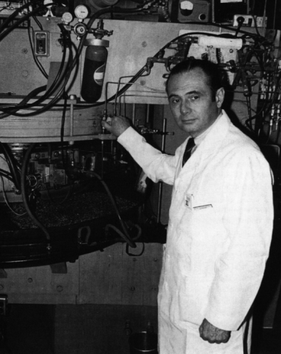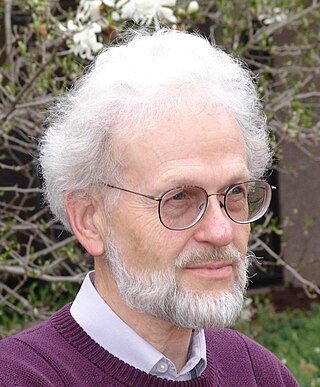Related Research Articles

Irène Joliot-Curie was a French chemist, physicist and politician, the elder daughter of Pierre Curie and Marie Skłodowska–Curie, and the wife of Frédéric Joliot-Curie. Jointly with her husband, Joliot-Curie was awarded the Nobel Prize in Chemistry in 1935 for their discovery of induced radioactivity, making them the second-ever married couple to win the Nobel Prize, while adding to the Curie family legacy of five Nobel Prizes. This made the Curies the family with the most Nobel laureates to date.

Positron emission, beta plus decay, or β+ decay is a subtype of radioactive decay called beta decay, in which a proton inside a radionuclide nucleus is converted into a neutron while releasing a positron and an electron neutrino. Positron emission is mediated by the weak force. The positron is a type of beta particle (β+), the other beta particle being the electron (β−) emitted from the β− decay of a nucleus.

Burton Richter was an American physicist. He led the Stanford Linear Accelerator Center (SLAC) team which co-discovered the J/ψ meson in 1974, alongside the Brookhaven National Laboratory (BNL) team led by Samuel Ting for which they won Nobel Prize for Physics in 1976. This discovery was part of the November Revolution of particle physics. He was the SLAC director from 1984 to 1999.

Raymond Davis Jr. was an American chemist and physicist. He is best known as the leader of the Homestake experiment in the 1960s-1980s, which was the first experiment to detect neutrinos emitted from the Sun; for this he shared the 2002 Nobel Prize in Physics.

Michel Matthew Ter-Pogossian was an American medical physicist. He was professor of radiology at the Washington University School of Medicine for over 30 years. A pioneer in nuclear medicine, he is best known for his research on the positron emission tomography (PET). He is considered one of its creators and often referred to as the "father of PET."
Joanna Sigfred Fowler is a scientist emeritus at the U.S. Department of Energy's Brookhaven National Laboratory in New York. She served as professor of psychiatry at Mount Sinai School of Medicine and director of Brookhaven's Radiotracer Chemistry, Instrumentation and Biological Imaging Program. Fowler studied the effect of disease, drugs, and aging on the human brain and radiotracers in brain chemistry. She has received many awards for her pioneering work, including the National Medal of Science.

David Robert Nygren is a particle physicist known for his invention of the time projection chamber. He is a Presidential Distinguished Professor of Physics, University of Texas at Arlington now. He has worked at Lawrence Berkeley National Laboratory since 1973. He has been called "the most distinguished developer of particle detection instruments in the country".

Gennady Andreyevich Mesyats is a Soviet and Russian physicist, founder of several scientific schools — high-current electronics and pulse electrophysics, one of the acknowledged world leaders in these areas.

Zang-Hee Cho is a Korean neuroscientist who developed the first Ring-PET scanner and the scintillation detector BGO. More recently, Cho developed the first PET-MRI fusion molecular imaging device for neuro-molecular imaging.

Alfred P. Wolf was an American nuclear and organic chemist. Wolf was chairman of the Chemistry Department at Brookhaven National Laboratory, research professor in the Department of Psychiatry at New York University a member of the National Academy of Sciences, The Journal of Nuclear Medicine said that his "discoveries were instrumental in the development of positron emission tomography (PET)" and that he "made pioneering contributions over nearly 50 years in the field of organic radiochemistry". The New York Times said that Wolf "helped create some of today's most sophisticated diagnostic tools" and that he "advanced the field of organic radiochemistry, radiopharmacology and nuclear medicine" throughout his career of 50 years. The National Academy of Sciences said that "he pioneered the development of labeling techniques that used the reactions of hot atoms".
The index of physics articles is split into multiple pages due to its size.

Sau Lan Wu is a Chinese American particle physicist and the Enrico Fermi Distinguished Professor of Physics at the University of Wisconsin-Madison. She made important contributions towards the discovery of the J/psi particle, which provided experimental evidence for the existence of the charm quark, and the gluon, the vector boson of the strong force in the Standard Model of physics. Recently, her team located at the European Organization for Nuclear Research (CERN), using data collected at the Large Hadron Collider (LHC), was part of the international effort in the discovery of a boson consistent with the Higgs boson.
Ady Hershcovitch is a plasma physicist best known for his 1995 invention, the plasma window, which was later patented.. In the plasma window, a plasma separates air from a vacuum by preventing the air from rushing into the vacuum. This scientific development can facilitate non-vacuum ion material modification, manufacturing of superalloys, and high-quality non-vacuum electron-beam welding. The device has been compared to the force field in the Star Trek TV series. He is well known for his work in plasma physics at Brookhaven National Laboratory. He has over 80 publications and 15 patents.
Thomas Marbory Antonsen Jr. is an American physicist, a Distinguished Professor in the Department of Physics and the Department of Electrical and Computer Engineering at the University of Maryland.
William J. Willis was an American experimental particle physicist.
John Robert Cary is a professor of physics at the University of Colorado Boulder and CEO of Tech-X Corporation, which he co-founded in 1994.
Noah Hershkowitz was an American experimental plasma physicist. He was known for his pioneering research on the understanding of plasma sheaths, solitons and double layers in plasmas, as well as the development of the emissive probe which measures the plasma potential.

Ilan Ben-Zvi is an accelerator physicist and academic. He was the associate chair for accelerator R&D at the Collider-Accelerator Department (C-AD), and is a distinguished scientist emeritus at the Collider-Accelerator Department (C-AD) at Brookhaven National Laboratory.
Vesna Sossi is a Canadian medical physicist at the University of British Columbia, where she is a professor in the Department of Physics and Astronomy and adjunct professor of medicine. Her research interests include theranostics and the use of positron emission tomography in the study of Parkinson's disease. She is president of the IEEE Nuclear & Plasma Sciences Society (NPSS), and a distinguished lecturer for NPSS.
References
- 1 2 3 4 IEEE
- ↑ "BNL Newsroom | Brookhaven Lab Scientist Veljko Radeka Shares Inaugural American Physical Society Division of Particles and Fields Instrumentation Award". www.bnl.gov. Retrieved 2017-10-04.
- ↑ "Gennady Mesyats | Global Energy Prize". www.globalenergyprize.org. Retrieved 2017-10-04.
- ↑ "Charles Kennedy Birdsall". people.eecs.berkeley.edu. Retrieved 2017-10-04.